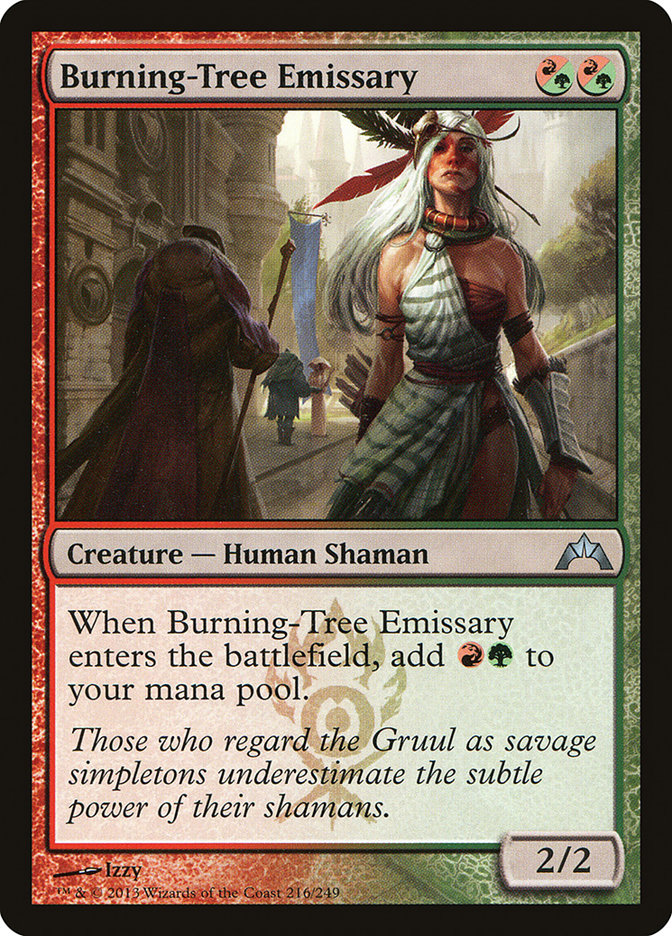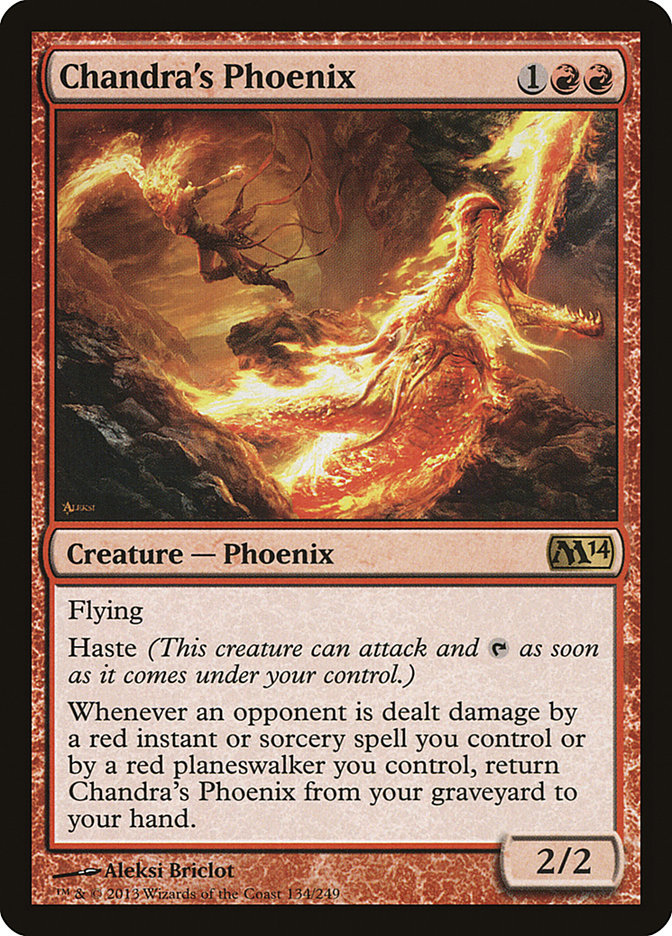Last weekend was the release of Theros, and the StarCityGames.com Standard Open in Worcester kicked off the Standard season. The tournament saw a smattering of control and midrange decks perform well. However, I myself decided to go aggressive.
Creatures (30)
- 2 Goblin Shortcutter
- 4 Chandra's Phoenix
- 4 Gore-House Chainwalker
- 4 Rakdos Cackler
- 4 Burning-Tree Emissary
- 4 Firefist Striker
- 4 Foundry Street Denizen
- 4 Firedrinker Satyr
Lands (22)
Spells (8)

Owen Turtenwald and I played the same 73 out of 75 cards. While my own result was less than stellar, Owen made it to the Top 8!
Our version of Mono-Red Aggro was just about the fastest, most brutal deck that we could conceive of. However, even looking at the decklist in text form doesn’t do it justice. A good draw will dump four or more creatures on the table by turn 4 and have the opponent facing upwards of fifteen damage by that point. Particularly when you’re on the play, many games can be over before they begin.
In a Standard format featuring some of the most powerful lategame spells in recent memory—Sphinx’s Revelation; Aetherling; Elspeth, Sun’s Champion—it’s great to feel like you’re simply playing a different game than your opponent. Your goal isn’t to beat these cards in a fair fight; it’s simply to ignore them or to win the game before your opponent can even cast them! Nothing in the deck costs more than three mana, and this configuration proved to be as fast and consistent as we had hoped.
Mutavault
In my opinion, Mutavault is the best card in Mono-Red Aggro.
Mana flood is the single most common way to lose with a deck like Mono-Red Aggro, and Mutavault is a good solution. If some supernatural force could guarantee me that I would draw exactly two or three Mountains every game, I’d play Mono-Red Aggro in every Standard tournament for the rest of the season! However, this doesn’t mean that you can simply cut your land count to a psychotically low number because you would end up mulliganing too often. Also, despite the low curve of the deck, missing land drops can interfere with the speed of Mono-Red Aggro, which almost defeats the purpose of playing the deck in the first place.
Mutavault is the perfect solution. Owen Turtenwald played 22 lands in his deck. (I myself played 21, but with the benefit of hindsight, I’m now advocating Owen’s mana base). 22 is a comfortable number where you can expect to hit your third land drop on time in a reasonably high portion of your games. However, only eighteen of these lands are Mountains; four are creatures with the same capability to beat down as everything else in your deck!
The greatest thing about Mutavault—and perhaps the one that’s least obvious before seeing Mono-Red Aggro in action—is that it cannot be killed by sorcery-speed removal. This includes cards like Detention Sphere, but more than anything I’m talking about board sweepers: Supreme Verdict and Anger of the Gods.
Since the strategy of Mono-Red Aggro is basically to play as many weenie creatures as quickly as possible, board sweepers are its natural enemy. In the absence of Supreme Verdict, it’s very difficult for control decks to beat you. However, the reality is that Supreme Verdict is a popular card, and you have to be prepared to beat it. Mutavault is a great way to do so.
A typical game against control goes like this. Your opponent may cast a permission spell or something like Azorius Charm in an attempt to stem the bleeding. But inevitably they’ll fall behind, and you’ll be able to start connecting with two or three creatures very quickly. On turn 4, if they’re lucky, they’ll hit four mana and play Supreme Verdict, but by that point they’ll already be down in the six-to-ten life range. At this point, you hardly need to worry about rebuilding an army; you can just start activating your Mutavaults and use a burn spell or two to finish the job before they can stabilize with Sphinx’s Revelation or planeswalkers.
Burning-Tree Emissary
I’ve mentioned a number of times how important it is to have as many creatures as possible on the battlefield by turn 2 or 3. Well, what better way of doing that than playing a creature that’s free?
I’ve seen Mono-Red Aggro lists without Burning-Tree Emissary, but I strenuously object to this approach. Aside from lands, Burning-Tree Emissary is the best card in the deck, as it makes for the most impressive nut draws and simply fits perfectly with the plan of swarming the opponent.
There are very few quality removal spells in Standard that cost only one mana. Frequently, an opponent who is forced to rely on spot removal will start killing creatures one at a time starting on the second turn, but against Burning-Tree Emissary they’ll never be able to keep pace. Sure, they’ll take out your Firefist Striker, but your Rakdos Cackler and Emissary will continuously chip away for four damage as you continue playing creatures and he continues shooting them down one at a time.
Red Mana vs. Colorless Mana
I named Mutavault and Burning-Tree Emissary as the best cards in Standard Mono-Red Aggro, but there’s an important consequence of playing these cards. You find yourself with colorless mana in your mana pool a lot, and you have a diminished capability to cast red-heavy spells.
The best example of such a spell is Boros Reckoner, which was a staple in older versions of Mono-Red Aggro but is a lot more ambitious when you have four Mutavaults and only seventeen or eighteen Mountains. Reckoner is so good in certain matchups (the mirror for one) that Owen and I decided to get greedy and play three copies in our sideboard. However, as a maindeck card, it’ll simply be stuck in your hand too often if you try to play it alongside Mutavault.
Similarly, we tried to avoid cards like Ash Zealot in favor of more creatures that can be played off of Burning-Tree Emissary and Mutavault. We chose Firefist Striker, Goblin Shortcutter, and Gore-House Chainwalker, but Young Pyromancer is also a fine consideration. Also, look for the play of turn 3 playing a one-drop creature off of a Burning-Tree Emissary and using your green mana to activate Mutavault.
While I’m on the topic, I would be silly not to mention the exciting technology that Phillip Bertorelli, the winner of the StarCityGames.com Standard Open in Worcester, played in his Mono-Red Aggro deck.
Creatures (29)
- 4 Chandra's Phoenix
- 4 Ash Zealot
- 1 Gore-House Chainwalker
- 4 Rakdos Cackler
- 4 Burning-Tree Emissary
- 4 Firefist Striker
- 4 Boros Reckoner
- 4 Fanatic of Mogis
Lands (21)
- 21 Mountain
Spells (10)

Mr. Bertorelli constructed his deck around Fanatic of Mogis, which uses the new devotion mechanic to simulate the Hellriders and Hero of Oxid Ridges of years past. I’ll be the first (well, I suppose I’m a few days late) to acknowledge that Fanatic of Mogis is a great card. A 4/2 body is fairly respectable, and the ability to shoot the opponent for as much as six or seven damage is as good as it gets. Of the four-drops available to a fast mono-red deck—Chandra, Pyromaster; Forge[/author]“]Purphoros, God of the [author name="Forge"]Forge[/author]; Burning Earth—Fanatic seems like the best to me.
However, I’m not willing to abandon my Mutavaults. I suggest one of these options:
A) Play a higher land count. 23 or 24 lands with some number of Mutavaults would be fine.
B) Omit Fanatic of Mogis; you don’t necessarily need a four-drop creature.
C) Play the Fanatic at less than its maximum power; you don’t necessarily need Boros Reckoner in your deck, as shooting the opponent for four or five damage will frequently be good enough to win the game anyway.
Chandra’s Phoenix
Not to fear! Boros Reckoner isn’t even the best three-drop available, not by a mile! Chandra’s Phoenix is the best follow-up to a turn 1 and turn 2 creature that a red mage could ask for. Even with an average draw, the haste on Chandra’s Phoenix will allow your Firefist Striker to trigger right away. Phoenix simply represents fast, reliable damage, which is exactly what you want.
There are two other abilities on the card that are worth talking about. The first is flying, which many people have a tendency to view as more of a Limited mechanic. However, the reality is that the most difficult cards for Mono-Red Aggro to beat (other than perhaps board sweepers) are things like Voice of Resurgence, Loxodon Smiter, and Boros Reckoner. Phoenix gives you a way to get past (or over!) these cards. If you can get in six or eight damage early on, it’s frequently no challenge to finish the job with a Phoenix or two backed up by some burn.
Finally, there’s the recursion of the Phoenix from your graveyard. This won’t come up every game, but it can be a deciding factor in a game that goes long. It’s often remarkable how much staying power Mono-Red Aggro can have for a deck where every spell costs three mana or less. Phoenix recurring after a Supreme Verdict is a great way to maintain constant pressure on a control player and to transform your unexciting Shocks into something that represents a huge amount of damage. Be wary though; Chandra’s Phoenix, for one reason or another, is unable to rise from the ashes of an Anger of the Gods, so barring some kind of "coolness errata" this is a risk that we have to be aware of.
Firefist Striker & Goblin Shortcutter
Just as the Phoenix is one way to push damage through a giant blocker, Firefist Striker and Goblin Shortcutter are two others. I believe that Firefist Strike is the next best two-drop creature after Burning-Tree Emissary and that it would be a big mistake to play fewer than four.
Goblin Shortcutter is a little less exciting because it represents a one-time effect and only in a narrow window. However, I’d much prefer to draw one copy of Shortcutter and one copy of Gore-House Chainwalker than to simply draw two copies of Gore-House Chainwalker.
The rest of the decklist requires minimal explanation. In Rakdos Cackler, Firedrinker Satyr, and Foundry Street Denizen, we have every one-drop creature that attacks for more than one damage. In Shock and Lightning Strike, we have the most efficient burn spells in Standard. Gore-House Chainwalker is a reasonable beater that survives the -1/-1 effect from Golgari Charm. Also worth noting is that while Owen omitted the card, I played two copies of Magma Jet. It’s a good card, though I think it’s worse than Shock and Lightning Strike.
I honestly can’t say what the future holds for Mono-Red Aggro. Will it become a dominant force in Standard? Will Fanatic of Mogis be the next big thing? These are questions that I’m not able to answer at this time. What I can say for sure is that Owen and I were quite pleased with the decklist that I offered above. Take it to your next Standard tournament and you’ll have as good a chance as anybody out there! I hope you’ll give it a try; you won’t be disappointed.





